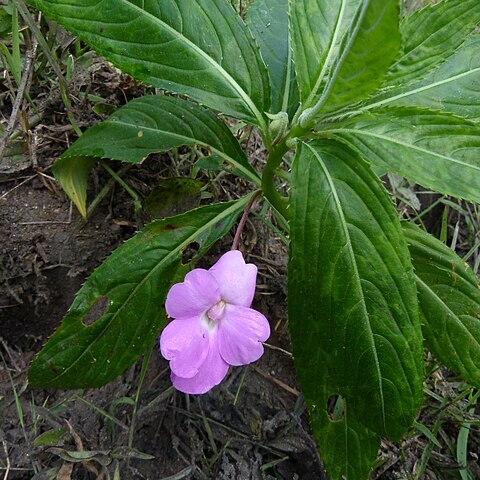Lateral united petals very variable in size, (13) 17–25 (30) mm. long, deeply 2-lobed; lobes nearly always ± overlapping, usually glabrous, rarely pubescent outside; anterior lobe 10–18 × 7–15 mm., obliquely semi-elliptic, semi-circular or rarely obovate, entire, with the lower margin usually ± straight; posterior lobe usually somewhat smaller (very rarely a little larger) than the anterior one, usually obovate, rarely subcircular, entire (see t. 26 fig. 13).
Posterior sepal 9–14 mm. long, c. 2·5 mm. deep, shallowly and obliquely navicular, abruptly constricted into the spur, distally caudate, usually ± densely pilose, rarely glabrous; spur up to 5·5 cm. long, rather slender, subconical in the upper half, cylindric in the lower one, with a subacute end, ± densely pilose, rarely glabrous, strongly incurved when young, slightly incurved or often nearly straight when older.
Perennial herb usually much branched; stems up to 1·5 m. long or even more, succulent, prostrate or ascending, rarely erect, red or green tinged with red, usually somewhat swollen at the nodes, glabrous or hairy (sometimes all over) with a very dense velvety indumentum.
Flowers axillary, solitary or in clusters of 2 or 3, pale purple or violet; bracts up to 4 mm. long, lanceolate-triangular or subulate, acute, usually densely pilose, rarely glabrous; pedicels up to 9 cm. long, slender, pilose or glabrous.
Anterior petal 8–15 mm. high and up to 17 mm. broad (when flattened), dorsally very narrowly cristate with crest often rim-like, apex usually entire, mucronate.
Lateral sepals 4–7 × 1·5–2·5 (3) mm., lanceolate to ovate-lanceolate, rarely oblong-lanceolate, acuminate, usually ± densely pilose, sometimes glabrous.
Seeds numerous, c. 2·5 × 1·7 mm., obovate in outline, brownish, with a papillose surface, glabrous.
A herb that grows in damp places. It grows 1 m high.
Capsule up to 1·8 cm. long, fusiform, glabrous.
Ovary glabrous.


